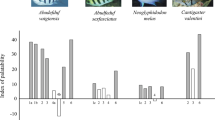Summary
Observations and experiments carried out on a coral reef off the Pacific coast of Panamá demonstrated that shrimp (Alpheus lottini) and crab (Trapezia spp.) symbionts that protect their host coral (Pocillopora elegans) can detect an approaching sea star predator (Acanthaster planci) by chemical cues. Simulated feeding attacks by Acanthaster in sealed transparent bags elicited only 0.5 defensive responses (snipping at spines and tube feet, jerking the sea star, and snapping) per 3 min; defensive behavior increased significantly to 4 and 5 responses, respectively, for Acanthaster in perforated bags and for Acanthaster in direct contact with coral. Neutralized (boiled) Acanthaster elicited only 3 defensive interactions per 3 min compared with 12 interactions for live Acanthaster. Simulated feeding attacks by Oreaster, a non-corallivorous sea star, elicited only 0.5 defensive responses per 3 min, whereas Oreaster introduced with “Acanthaster water” increased the level of defensive responses to 7. These results suggest that chemical, and to a lesser extent visual (physical presence and movements of sea star), cues stimulate the defensive behavior of the symbiotic crustaceans. The ability to detect a predator at a distance is probably advantageous because in responding only to an actual threat it minimizes the time the defending symbionts spend in an exposed position on the terminal branches of the host coral and because it alerts the crustaceans to sea stars feeding at night.
Similar content being viewed by others
References
Abele LG, Patton WK (1976) The size of coral heads and the community biology of associated decapod crustaceans. J Biogeogr 3:35–47
Barnes DJ, Brauer RW, Jordan MR (1970) Locomotory response of Acanthaster planci to various species of coral. Nature Lond 228:342–344
Branham JM, Reed SA, Bailey JH, Caperon J (1971) Coral-eating sea stars Acanthaster planci in Hawaii. Science 172:1155–1157
Bullock TH (1953) Predator recognition and escape responses of some intertidal gastropods in the presence of starfish. Behaviour 5:130–140
Castro P Notes on symbiotic decapod crustaceans from Gorgona Island, Colombia, with a preliminary revision of the eastern Pacific species of Trapezia (Brachyura, Xanthidae), symbionts of scleractinian corals. An Inst Inv Mar Punta Betín 12: (in press)
Dayton PK (1975) Experimental evaluation of ecological dominance in a rocky intertidal algal community. Ecol Monogr 45:137–159
Dimock RV Jr, Dimock JG (1969) A possible “defense” response in a commensal polychaete. The Veliger 12:65–68
Feder HM (1963) Gastropod defensive responses and their effectiveness in reducing predation by starfishes. Ecology 44:505–512
Fricke HW (1974) Öko-Ethologie des monogamen Anemonen fisches Amphiprion bicinctus (Freiwasseruntersuchung aus dem Roten Meer). Z Tierpsychol 36:429–512
Glynn PW (1973) Acanthaster: effect on coral reef growth in Panamá. Science 180:504–506
Glynn PW (1974) The impact of Acanthaster on corals and coral reefs in the eastern Pacific. Environ Conservation 1:237–246
Glynn PW (1976) Some physical and biological determinants of coral community structure in the eastern Pacific. Ecol Monogr 46:431–456
Glynn PW (1977) Interactions between Acanthaster and Hymenocera in the field and laboratory. In: Taylor DL (ed) Proc., Third Intl. Coral Reef Symp., Vol 1. University of Miami, Miami, p 209–215
Goreau TF, Lang JC, Graham EA, Goreau PD (1972) Structure and ecology of the Saipan reefs in relation to predation by Acanthaster planci (Linnaeus). Bull Mar Sci 22:113–152
Janzen DH (1966) Coevolution of mutualism between ants and acacias in Central America. Evolution 20:249–275
Kittredge JS, Takahashi FT, Lindsey J, Lasker R (1974) Chemical signals in the sea: marine allelochemics and evolution. Fish Bull 72:1–11
Knudsen JW (1967) Trapezia and Tetralia (Decapoda, Brachyura, Xanthidae) as obligate ectoparasites of pocilloporid and acroporid corals. Pacific Sci 21:51–57
Laxton JH (1974) Aspects of the ecology of the coral-eating starfish Acanthaster planci. Biol J Linn Soc 6:19–45
Mackie AM, Grant PT (1974) Interspecies and intraspecies chemoreception by marine invertebrates. In: Grant PT, Mackie AM (eds) Chemoreception in marine organisms. Academic Press, New York, London, p 105–141
Margolin AS (1964) The mantle response of Diodora aspera. Anim Behav 12:187–194
Mariscal RN (1970) The nature of the symbiosis between Indo-Pacific anemone fishes and sea anemones. Mar Biol 6:58–65
Mauzey KP, Birkeland C, Dayton PK (1968) Feeding behavior of asteroids and escape responses of their prey in the Puget Sound region. Ecology 49:603–619
Ormond RFG, Hanscomb NJ, Beach DH (1976) Food selection and learning in the crown-of-thorns starfish, Acanthaster planci (L.). Mar Behav Physiol 4:93–105
Patton WK (1974) Community structure among the animals inhabiting the coral Pocillopora damicornis at Heron Island, Australia. In: Vernberg WB (ed) Symbiosis in the sea. Univ S Carolina Press, Columbia, South Carolina, p 219–243
Pearson RG, Endean R (1969) A preliminary study of the coral predator Acanthaster planci (L.) (Asteroidea) on the Great Barrier Reef. Fish Notes (Depart Harbours Mar, Queensland) 3:27–68
Smith WL (1977) Beneficial behavior of a symbiotic shrimp to its host anemone. Bull Mar Sci 27:343–344
Weber JN, Woodhead PMJ (1970) Ecological studies of the coral predator Acanthaster planci in the South Pacific. Mar Biol 6:12–17
Whittaker RH, Feeny PP (1971) Allelochemics: chemical interactions between species. Science 171:757–770
Author information
Authors and Affiliations
Rights and permissions
About this article
Cite this article
Glynn, P.W. Defense by symbiotic crustacea of host corals elicited by chemical cues from predator. Oecologia 47, 287–290 (1980). https://doi.org/10.1007/BF00398518
Received:
Issue Date:
DOI: https://doi.org/10.1007/BF00398518




